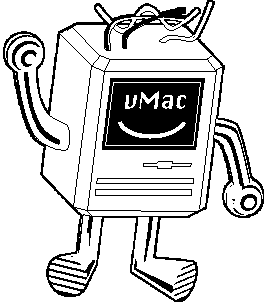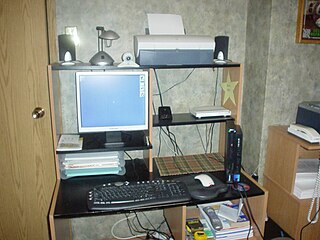Related Research Articles

PowerPC is a reduced instruction set computer (RISC) instruction set architecture (ISA) created by the 1991 Apple–IBM–Motorola alliance, known as AIM. PowerPC, as an evolving instruction set, has since 2006 been named Power ISA, while the old name lives on as a trademark for some implementations of Power Architecture-based processors.
Computer operating systems (OSes) provide a set of functions needed and used by most application programs on a computer, and the links needed to control and synchronize computer hardware. On the first computers, with no operating system, every program needed the full hardware specification to run correctly and perform standard tasks, and its own drivers for peripheral devices like printers and punched paper card readers. The growing complexity of hardware and application programs eventually made operating systems a necessity for everyday use.

A/UX is Apple Computer's implementation of the Unix operating system for Macintosh computers, integrated with System 7's graphical interface and application compatibility. Launched in 1988 and discontinued in 1995 with version 3.1.1, it is Apple's first official Unix-based operating system. A/UX requires select models of 68k-based Macintosh with an FPU and a paged memory management unit (PMMU), including the Macintosh II, SE/30, Quadra, and Centris series. It is not the predecessor to macOS, a variant of UNIX currently bundled with Apple's desktop computers.
Windows Virtual PC is a virtualization program for Microsoft Windows. In July 2006 Microsoft released the Windows version as a free product. In August 2006, Microsoft announced the Macintosh version would not be ported to Intel-based Macintosh computers, effectively discontinuing the product as PowerPC-based Macintosh computers are no longer manufactured. The newest release, Windows Virtual PC, does not run on versions of Windows earlier than Windows 7, and does not officially support MS-DOS or operating systems earlier than Windows XP Professional SP3 as guests. The older versions, which support a wider range of host and guest operating systems, remain available. Starting with Windows 8, Hyper-V supersedes Windows Virtual PC.

A home theater PC (HTPC) or media center computer is a convergent device that combines some or all the capabilities of a personal computer with a software application that supports video, photo, audio playback, and sometimes video recording functionality. In recent years, other types of consumer electronics, including gaming systems and dedicated media devices, have crossed over to manage video and music content. The term "media center" also refers to specialized application software designed to run on standard personal computers.

vMac was an open source emulator for Mac OS on Windows, DOS, OS/2, NeXTSTEP, Linux-Unix, and other platforms. Although vMac has been abandoned, Mini vMac, an improved spinoff of vMac, is currently developed. vMac and Mini vMac emulate a Macintosh Plus and can run Apple Macintosh System versions 1.1 to 7.5.5. vMac and Mini vMac support CPU emulation from Motorola 68000 to 68040, display output, sound, floppy disk insert, HFV image files, and more. Some vMac ports include extra features such as CD-ROM support, basic serial port (SCC) support, Gemulator ROM board support, and various performance improvements. Although the website is still in operation, most vMac development slowed to a halt in 1999, and no official releases have been made since. Many of the developer e-mail addresses listed on the website are not currently working.

Linux for PlayStation 2 is a kit released by Sony Computer Entertainment in 2002 that allows the PlayStation 2 console to be used as a personal computer. It included a Linux-based operating system, a USB keyboard and mouse, a VGA adapter, a PS2 network adapter, and a 40 GB hard disk drive (HDD). An 8 MB memory card is required; it must be formatted during installation, erasing all data previously saved on it, though afterwards the remaining space may be used for savegames. It is strongly recommended that a user of Linux for PlayStation 2 have some basic knowledge of Linux before installing and using it, due to the command-line interface for installation.

The Motorola A780 is a cellular PDA running the Linux operating system.
The Apple–Intel architecture, or Mactel, is an unofficial name used for Apple Macintosh personal computers developed and manufactured by Apple Inc. that use Intel x86 processors, rather than the PowerPC and Motorola 68000 ("68k") series processors used in their predecessors. With the change in architecture, a change in firmware became necessary; Apple selected the Intel-designed Extensible Firmware Interface (EFI) as its comparable component to the Open Firmware used on its PowerPC architectures, and as the firmware-based replacement for the PC BIOS from Intel. With the change in processor architecture to x86, Macs gained the ability to boot into x86-native operating systems, while Intel VT-x brought near-native virtualization with Mac OS X as the host OS.
Mac gaming refers to the use of video games on Macintosh personal computers. In the 1990s, Apple computers did not attract the same level of video game development as Microsoft Windows computers due to the high popularity of Microsoft Windows and, for 3D gaming, Microsoft's DirectX technology. In recent years, the introduction of Mac OS X and support for Intel processors has eased porting of many games, including 3D games through use of OpenGL and more recently Apple's own Metal API. Virtualization technology and Boot Camp also permit the use of Windows and its games on Macintosh computers. Today, a growing number of popular games run natively on macOS, though as of early 2019, a majority still require the use of Microsoft Windows.

Executor is a software application that allows Motorola 68000-based classic Mac OS programs to be run on various x86-based operating systems. Executor was created by ARDI. As of 2005, Executor development has been indefinitely postponed; as of 2008, it was made available as open source software.
MKS Toolkit is a software package produced and maintained by PTC that provides a Unix-like environment for scripting, connectivity and porting Unix and Linux software to Microsoft Windows. It was originally created for MS-DOS, and OS/2 versions were released up to version 4.4. Several editions of each version, such as MKS Toolkit for developers, power users, enterprise developers and interoperability are available, with the enterprise developer edition being the most complete.
Thinstation is a free and open source Linux implementation of a thin client operating system. It only requires standard 32-bit x86 PC hardware and can boot directly from the network via PXE or Etherboot from a TFTP server, or from local devices such as Hard disks, CompactFlash drives, USB keyrings and CD/DVDs. The minimum requirement is an i686 class CPU and RAM dependent on the intended use, typically 64–256 MB.
A home server is a computing server located in a private residence providing services to other devices inside or outside the household through a home network or the Internet. Such services may include file and printer serving, media center serving, web serving, web caching, file sharing and synchronization, calendar and contact sharing and synchronization, account authentication and backup services.
MKS X/Server, a commercial X server developed by MKS Inc., allows users to access Unix/Linux systems from a PC computers which run a Microsoft Windows operating system. The product offers both a full 32-bit X server and a native 64-bit X server that operate on various versions of Microsoft Windows.

The Macintosh is a family of personal computers designed, manufactured, and sold by Apple Inc. since January 1984.

DisplayLink is a semiconductor and software technology company. DisplayLink USB graphics technology is designed to connect computers and displays using USB, Ethernet, and WiFi. It also allows multiple displays to be connected to a single computer. DisplayLink's primary customers are notebook OEMs, LCD monitor manufacturers and PC accessory vendors, supporting the Microsoft Windows, macOS, Android, ChromeOS and Linux operating systems.

The SheevaPlug is a "plug computer" designed to allow standard computing features in as small a space as possible.
IBM BigFix formerly IBM Endpoint Manager, Tivoli Endpoint Manager (TEM) and before that, BigFix, is a systems-management software product developed by IBM for managing large groups of computers running Windows, Mac OS X, VMware ESX, Linux or UNIX, as well as various mobile operating systems such as Windows Phone, Symbian, iOS and Android. IBM BigFix provides system administrators with remote control, patch management, software distribution, operating system deployment, network access protection and hardware and software inventory functionality.
References
- ↑ "Home Monitoring and Control System". Motorola. Archived from the original on 2006-07-17. Retrieved 2006-07-18.
- ↑ "Homesight Wireless Easy Start Kit". Motorola. Archived from the original on 2006-07-16. Retrieved 2006-07-18.
- ↑ "Homesight Remote home page". SourceForge . Retrieved 2007-06-11.
- 1 2 "Homesight Remote project page". SourceForge. Retrieved 2007-06-11.